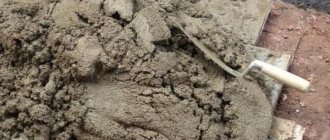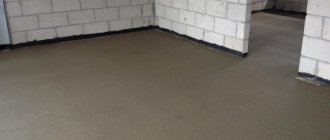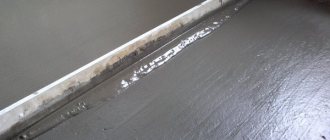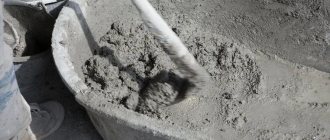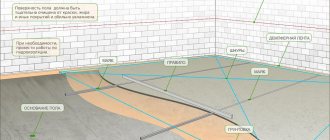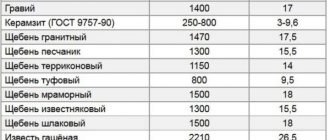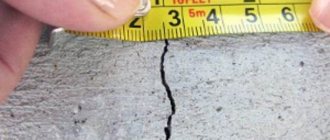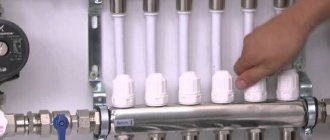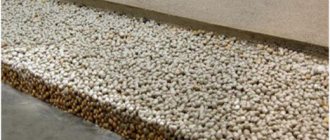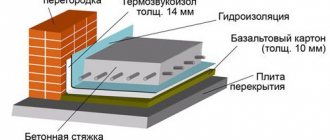What is the density (specific gravity, volumetric weight) of cement-sand screed kg m3
Many technologies and materials are used to install floors and floor coverings, the choice of which depends on the purpose and operating conditions of the room or facility.
The universal materials for performing this type of work are cement-sand mortars and concrete. When choosing, you should take into account the various characteristics of the material for leveling, one of which is the density of the cement-sand screed in kg/m3. This indicator determines the total weight of the screed and the load on the base of the foundation or interfloor ceilings, exceeding which can lead to a decrease in the overall reliability of the building.
General characteristics and types
First, let's look at why a floor screed is needed and what types of this structure are.
Cement floor screed is a traditional way of leveling the floor base, made from a mixture of cement and sand.
Purpose and advantages of the screed:
- Levels the surface.
- Strengthens the strength of the floor.
- Improves the thermal and waterproofing properties of the floor.
- The DSP base has a long service life.
- Materials for mixing the solution are inexpensive
Flaws:
- It takes a long time for the mixture to dry - more than 1 month.
- When working with the solution, dirt and dampness are formed.
- The DSP has a lot of weight, placing a large load on the base of the building.
Types of cement screed
- Connected - provides for strong contact of the solution with the floor covering. Used to level the surface.
- Separated by a layer of waterproofing, the mixture is poured onto a pre-laid sheet of waterproofing. This lining prevents contact of the base with the solution.
Types of cement floor screed Based on the structure of the solution, the screed is divided into two subtypes:
- Semi-dry - involves the use of a cement-sand mixture with a small amount of water. This type is called - floor screed using German technology.
- Wet is a cement-sand mixture with a lot of water. When a liquid consistency is obtained, the solution is poured onto the base.
Each type is used for different purposes. The screed can only be used for leveling or for installing heated floors with a heat-insulating pad. Before choosing one type or another, it is worth deciding what the screed is needed for, what role it will play, taking into account all the nuances of construction.
SNiP cement-sand screed
Cement-sand mortars for leveling floors are widely used in industrial, civil and individual construction. In the latter case, work is not always carried out according to project documentation, and the owners often take responsibility for choosing materials and leveling the base, relying on personal experience, advice from friends or information from the Internet. One of the options for protecting against possible errors in the absence of a project is to refer to publicly available construction industry standards.
Requirements for the design of floors in buildings for various purposes are regulated by the document SP 29.13330.2011 “Code of Rules. Floors”, in which, taking into account the emergence of new building materials and technologies, the introduction of additional safety requirements, the rules applied since 1988 SNiP 2.03.13-88 “Floors” have been updated. Sections of the set of rules determine the general requirements for the structural design of floors, as well as for the constituent elements: coating, interlayer, hydro- and vapor barrier, screed, underlying layer, foundation soil.
As the main criteria for making technical decisions, SP 29.13330.2011 determines the nature and intensity of mechanical effects on the floor, the intensity of exposure to liquids or aggressive environments, temperature conditions of operation, and ensuring sanitary and hygienic requirements. For industrial premises, special requirements are also taken into account, taking into account the specifics of the facility - the possibility of dust formation, the accumulation of static charges or sparking, the ability to clean and clean.
The information provided in the text of the document and in the appendix tables may also be useful for individual developers when choosing the type of floor and its covering, materials and performance of work, including the installation of a leveling screed.
Calculation of the required amount of binder
Now it remains to find out how much cement will be spent on pouring the flooring. Many people make a mistake before calculating the consumption of components for a floor screed, not taking into account the fact that the shrinkage of the screed after preparing the mixture will be at least ¼ of its volume. This is due to the fact that after adding water to the concrete or solution, all the ingredients fill all the voids corresponding to their size.
In addition, when adding components to a solution, it is necessary to take into account that their volumetric parameters differ from mass ones. It is known that 1 m 3 of the binder component can weigh from 1100 to 1600 kg. This indicator largely depends on the moisture content of the material and its bulk density. In order not to complicate the task, it is generally accepted that 1 m 3 contains 1300 kg of binder. From this it turns out that the volume of a bag of cement weighing 50 kg is only 38.4 liters.
How to calculate the consumption of floor screed, since simple calculation formulas turned out to be unacceptable? It turns out that it will not be possible to obtain 1 m 3 of coating from 200 kg of binder component, the same amount of water and 600 kg of sand (with the proportions of ingredients 1: 1: 3). This will require more cement.
It should be borne in mind that the shrinkage of the finished mixture depends on factors such as the size of the component fractions. It is almost impossible to calculate this value at home, so a 25% reduction in volume will be taken as a basis. When calculating, only dry components (1:3) will be taken into account.
An example has already been given above of calculating the volume of solution required to fill a floor screed with a thickness of 0.1 m and an area of 16 m2. Further calculations to calculate the required amount of binder will be tied to this result (1.6 m3) for clarity.
- So, the share of cement is ¼ of the mixture.
- Without taking into account shrinkage, its volume in the solution (part) will be 0.4 m 3 (1.6:4 = 0.4).
- Now you need to take into account 25 percent shrinkage. After preparing the mixture, each part of the cement loses ¼ in volume. This means that in order to get 1.6 m 3 of floor screed, it needs to be poured into the solution not 0.4, but 0.5 m 3 (0.4 + 0.4: 4 = 0.5).
- ½ m 3 of binder will weigh 650 kg (0.5 × 1300 = 650).
- It turns out that for pouring you need to buy 13 50-kilogram bags of cement (650:50=13).
For floor screeding, not only cement-sand mortar, but also concrete can be used. The density of the filler in it depends on the crushed stone material.
- Granite has a density of 1300-1700 kg/m3.
- For crushed limestone minerals this figure is 1250-1300.
- The density of gravel is 1350-1450.
It should be recalled that the density of 1 m 3 of granite itself differs from the density of 1 m 3 of its crushed stone, since there are voids between the crushed particles of the material.
Pouring screed is one of the most important stages in construction work. Cement floor screed is used to level horizontal surfaces. The consumption of materials and all major construction and finishing work will depend on its quality.
Even with extensive experience in using screed, you cannot guarantee its quality in advance, which is determined based on the consistency of the finished solution and correctly selected proportions. Calculating the materials for floor screed included in the dry mixture, which will be used subsequently, is a simple but responsible task that only an experienced professional can handle.
Screed density and specific gravity of cement and sand
To construct a cement-sand screed (CSS), depending on the criteria specified by the operating conditions, various types of material can be used, differing in composition, density and strength:
- concrete with heavy filler;
- concrete with light filler;
- cement-sand mortar;
- dry mixes.
With heavy filler - granite screenings
The filler based on granite crushed stone screenings is the final product of the production of commercial crushed stone with a fraction of up to 10 mm. Concrete screed with granite filler is highly durable, frost-resistant and is used in industrial construction. In civil and residential construction it is used for premises with high operational loads - for basements and ground floors, garages, utility and storage spaces.
The density of concrete prepared using granite screenings is 1400-2200 kg/m³, which classifies it as heavy. The volumetric weight of a 5 cm thick screed for the specified density range ranges from 70 to 110 kilograms per 1 m2, which is a significant additional load on interfloor ceilings, floors with a soil or wooden base.
Light types of solutions - perlite, polystyrene, granules
In many cases, using a light screed will be more effective. It is used in cases where a large difference in heights is eliminated by leveling, when laying pipelines and communications in the floor, and also when it is necessary to obtain additional heat and sound insulating properties of the floor using a screed.
The density of light screed mortars ranges from 500 to 1800 kg/m³, depending on the type of filler and filler, and their proportions in the mixture. In terms of strength, light screed is inferior to mixtures with heavy filler, so sometimes it is used as an intermediate layer with final leveling with stronger solutions.
Several materials are used as fillers for light screeds, the addition of which to the mixture allows one to obtain various technical characteristics:
- Perlite is a porous rock that has good heat and sound insulation, high absorbency, fire resistance, and chemical inertness. For the preparation of building concrete and mortars, expanded perlite obtained by heat treatment of raw materials with a density of about 100 kg/m³ is used; the density of the mixture, depending on the composition of other components, ranges from 400 to 1000 kg/m³.
- Vermiculite is a natural mineral with a layered structure; expanded rock is used in construction. As a filler for mortars and concrete, it has properties and characteristics similar to perlite.
- Expanded clay with a volumetric weight of 150 to 800 kg/m³, obtained by firing clay or shale. Its characteristics are high strength, frost resistance, chemical resistance, non-flammability, and environmental friendliness. Expanded clay crushed stone with a fraction of up to 10 mm is used as a filler or serves as a raw material for the preparation of expanded clay sand.
- Granulated polystyrene foam (from polymer raw materials). The density of CPS based on it ranges from 150 to 600 kg/m³; they have a high degree of sound and heat absorption, frost resistance, but low strength compared to other lightweight solutions.
Varieties: cement screed
- Messenger
. Typically used in high-rise buildings - the DSP here serves to level the floor slabs. To create a reliable base, you need good adhesion - connection - between the poured layer and the old one. That’s why the type of screed is called – connected. Its minimum layer is 3 cm. - Incoherent
. With this type of base, the new layer is not bonded to the old floor. For example, installation on a concrete base that has been previously polished or on a layer of insulating material. The minimum thickness of the screed is 5 cm. - Floating
. If the floor needs to be made warm, it is impossible to achieve a rigid adhesion of the screed to the base. When the insulating material changes its dimensions, the concrete layer placed above also lowers/raises. That’s why this screed is called floating. To create rigidity, which requires a minimum thickness of the cement-sand mass in this version of the screed, at least 6.5 cm.
All of these types of CPS have their own installation characteristics, but they are united by the use of sand-cement mortars. Sometimes, to increase reliability, reinforced fibers are added to the composition. This is usually fiberglass; there are additives from small parts of steel wire, but they are not used often. Reinforcement of the solution is required when the concrete layer is large.
Chaotically arranged fibers significantly increase the strength of the base and practically no cracks appear in it.
According to building rules, the minimum thickness of the screed is 3 cm. With the thinnest layer during the period when the mortar dries, the canvas will crack and the base will be unreliable. At the same time, concrete has a lot of weight: per 1 m2, a 10 mm layer weighs approximately 20 kg. And since the minimum thickness is 3 cm, then the minimum weight of 1 m2 of screed will be 60 kilos. Not every foundation is capable of supporting such a load without consequences. This can cause the foundation to shrink and crack. To reduce the weight of the screed, light binders, for example, expanded clay, are included in the solution. The mass of 1 cm of expanded clay concrete is 16 kilos. With volumetric footage being poured, the difference is significant.
Minimum and maximum screed thickness
SP 29.13330.2011 gives clear instructions on the minimum thickness of the screed layer to ensure the required floor slope: when laying on floor slabs, at least 20 mm, when laying on a waterproofing layer, on a heat and sound insulating layer - at least 40 mm. When covering pipelines (including in a heated floor system), the thickness of the screed must be at least 45 mm greater than the diameter of the pipelines. A smaller layer thickness can lead to cracking and destruction of the screed.
The minimum thickness of the screed layer recommended by experts is 30 mm. The optimal value of the screed is 40-50 mm; an increase in thickness entails excessive consumption of material, is limited by the permissible load-bearing capacity of the base even if light screeds are used, and requires additional reinforcement of the layer with reinforcement.
What is the consumption
Plastering work requires a certain amount of material; correct calculation of costs ensures the cost-effectiveness of layer formation.
The main factor that affects the consumption of the plaster mixture is the thickness of the layer. It is determined based on the level of unevenness on the surface. In new buildings, deviations are usually approximately 20 mm, rarely more. In most cases the layer varies in thickness from 6 mm to 20 mm.
Taking the average value of 13 mm, a flow rate of 15 kg/m2 is ensured. In practice, 1 bag of mixture should be enough to treat 2 m2 of surface, but the ability to use the composition and minimizing unused mixture also plays a role here.
Naturally, the consumption of mixtures is an imprecise value and can fluctuate greatly. If sand-cement plaster seems like an overwhelming task, you should contact specialists who can more reliably determine the amount of resource spent, especially important for large areas. Specialists can perform plastering by machine; this option has a number of advantages and will help save money or, at least, not overpay by saving material.
Density of cement-sand screed: specific gravity
To create a high-quality and durable foundation for any finishing floor covering, it is necessary to determine the load-bearing capacity of the entire structure.
The weight of the screed is quite large, and therefore it puts a lot of pressure on the base of the structure.
In cases where the work is not carried out using a ready-made mixture purchased in construction stores, but a composition prepared independently, accurate calculations should be made taking into account the characteristics of the materials used.
Manufacturers
The modern building materials market offers a fairly large selection of various mixtures and powders for various tasks. It is worth choosing products from trusted manufacturers who guarantee high quality components and their creation in accordance with technology.
"Monolith"
A large manufacturer that creates and sells cement-sand mixtures at a plant in Kirov. The range is quite large, it includes reliable and high-quality compositions of the M150 brand, well suited for plastering, sealing joints, and masonry indoors and outdoors.
We also sell reliable compositions of the M300 brand, which are relevant for the production of high-strength concrete structures.
Knauf
A well-known brand that supplies the market with high-quality cement and plaster mixtures in several lines (Sivener, Adhesive, Grünband, Unterputz). All products have excellent thermal insulation properties. Suitable for completing a full range of finishing works - interior/exterior. In most of the manufacturer’s mixtures, components are added to the composition to enhance positive properties.
"Real"
The manufacturer's products are popular and supply high-quality cement mixtures of the M75 and M150, M100 and M200 brands. The range allows you to choose what you need for finishing and repair work. Most dry mixes are supplemented with components to increase frost resistance, which expands the possibilities of working with them and allows them to be used both inside and outside.
Dauer
A German brand that offers inexpensive, high-quality DSP for finishing facades and walls indoors, pouring screeds, installing blocks and bricks.
The manufacturer's dry mixtures are very popular because they have low consumption and an affordable price, which, in general, can significantly reduce the cost of work.
"BaltPiterStroy"
A large Russian company supplying the market with cement-sand mortars of all brands. Also among the products you can find other components - rubble, gravel, crushed stone, sand, cement in bags and various reagents (anti-icing, for example).
"Stroyservis-Novablock"
Previously, the manufacturer’s cement-sand compositions were presented on the market under the Plita Milks brand. In addition to dry mixes, the product range includes a high-strength sand and gravel mixture of the M300 brand. All compositions are of very good quality, as they are produced on modern factory equipment on an industrial scale.
"Adamant SPB"
The plant offers a huge range of crushed stone, sand, cement, reinforced concrete products, and high-quality concrete. DSPs are represented by a variety of brands - the line includes both M100 and M400.
Selection of materials and mixture preparation
DSP or cement-sand screed is a necessary and fairly simple way to level surfaces. To create it you need sand, cement and water. The quantity of each component depends on their characteristics.
So, for example, if you take cement grade M150, then you will need three times more sand. If M500 grade cement is used to prepare the mixture, then sand is taken in accordance with the proportion of 1:5.
For a 50 kg bag, take 150 kg of sand
It is considered optimal to use cement grade M 150, therefore for this material weighing 50 kg you will need 150 kg of sand. As for the amount of water, it depends on the moisture content of the sand.
You can prepare a high-quality solution by taking:
- 1 bag (50 kg) of cement;
- 15 ten-liter buckets (150 kg) of dry sand;
- 27 liters of water.
The addition of wet sand will reduce the volume of water to 25 liters.
The weight of the cement-sand screed determines the pressure it will exert on the base of the structure. Accordingly, before starting work, it is necessary to clarify the thickness of the poured layer.
The screed must be at least 30 mm thick
The minimum thickness of the screed is 0.3 cm. Otherwise, after the solution hardens, the surface will become covered with cracks. Exceeding the maximum thickness of 0.5-1 cm leads to exceeding the permissible load on the base.
If this value reaches 8-10 cm, then the weight of the cement screed for each square meter will be about 150 kg. This is unacceptable and therefore experts recommend not to exceed the established parameters.
The density of the mixture depends on the quality of the material
Sand-cement mixture: weight and density of the solution at consumption per 1 m2
Each construction of a structure must begin with the calculation of the amount of materials required for this action. Accordingly, various questions arise regarding the quantity, quality and standard proportions for the mixture. Knowing the volume of materials, it is possible to significantly save on purchasing only the necessary components. You also won’t have to travel for additional amounts of mixture, only if unplanned work arises. How to calculate the consumption of cement-sand mixture?
A mixture of cement and sand - characteristics and preparation of mortar
As a result of mixing cement and sand, a sand-cement mixture is obtained, which, when water is added, becomes suitable for use. On a large scale of construction independent preparation of the mixture is often used , although there is also a DSP specially prepared at the enterprise.
If you purchase a factory-made DSP , then in its composition, in addition to the basic components, there are plasticizers and other additives. They are used to give the solution homogeneity and plasticity; some add frost-resistant additives for work in the cold season.
Preparation of cement-sand mortar
The preparation of cement mortar greatly depends on the brand of cement and the required mortar. From this the required ratio of ingredients is calculated.
The number of components strongly depends on the purpose of the mixture, so some types of work involve a smaller amount of sand (concreting) or, conversely, a larger amount (masonry).
For more flexible preparation of the solution, sand and cement should be mixed manually; the standard ratio is 1 to 3, but it can be 1 to 2-4. The mixtures are also different; a huge range covers most ordinary needs.
To avoid unnecessary costs for materials that are not useful in construction, you should make a calculation. It will help you more accurately determine the required amount of mixture.
But it is not always possible to achieve an exact value due to the lack of information about the density of the material, because it may differ.
The purpose of cement plays an important role when choosing a brand:
- m100 is used only for plastering walls, approximate consumption 550-570 kg/m3;
- m150 is usually used for bricklaying, cinder block or installation; in rare cases, for concreting, the consumption is 570-590 kg/m3;
- m200 masonry and installation mixture must be prepared 590-620 kg/m3;
- m300 is used for concreting and pouring areas that bear increased load, consumption 620-660 kg/m3;
- m400 for especially strong concrete structures, consumption ranges from 660-710 kg/m3.
When calculating the required materials per 1 m3, it is possible to quite accurately determine the brand and quantity of PCB . They are also interchangeable, if the use of M150 is recommended, the cement can be replaced with M200 and M100 without much damage to the calculations and strength of the structure.
How many materials will be needed - consumption per 1 m2, 1 m3
The amount of cement-sand mixture is calculated based on the cubic capacity of the room or site. You can easily calculate the footage using a regular tape measure, and then multiply the length by the width to get the area of the space that needs to be filled with cement.
The key parameter is the layer depth. Depth is a necessary indicator, as it directly affects consumption. On average, if the layer thickness is 10 mm, then 22 kg per m2 is required. For a 10 cm screed, 50 kg of M400 mixture is required.
To individually calculate the amount of mixture, you need to use the indicator 1 m3, this way you can calculate the volume of the solution. Here are some approximate calculations using a calculator to determine the amount of materials in construction.
If the area of the room is 100 m2, and the depth of the layer is 10 cm (must be converted to m), then it will be: 100 * 0.1 = 10 m3.
Very roughly, but per 1 m3 on average there are 555 - 713 kg of mixture; more accurate data should be contained on the packaging. If you mixed it by hand, you need to approximately calculate the required weight. The rule is that the higher the grade of the solution, the greater its weight.
M400 cement is characterized by a maximum weight of 700 kg per m3. As the grade decreases, the weight also decreases. M100 weighs approximately 550-600 kg per 1 m3.
This pattern is true for both manual and starting mixtures. The amount of dry mixture does not reflect its volume as a solution; 1 liter contains about 1.4 kg of dry mixture. Thus, if it is necessary to fill 10 m3, then the further calculation will be (using the example of M300):
(10 m3 * 650 kg)*1.4 = 9100 kg
Thus, to fill 10 m3 you will need a mixture in the amount of 6500 liters or 9100 kg of dry mixture .
Calculation of DSP for plaster
The quantity and cubic capacity of consumables for plastering a wall is quite difficult to determine. The reason is that the walls are rarely even, they usually have protrusions, recesses, and the layer in each area is slightly different.
It is necessary to determine the average depth of the layer in order to calculate the volume of the cement-sand mixture . For example, per 5 mm layer there is 7 kg of mixture per 1 m2.
The thickness of the plaster ranges from 5 to 30 mm . When plastering, it is worth considering the number of additional components; slaked lime is often added.
For large volumes of work, a batch is made consisting of:
- 4 bags of cement;
- 40 kg of slaked lime;
- 550 kg of sand;
- 100 liters of water.
So many ingredients comply with regulatory rules per 1 m3.
When plastering, the standard proportion of cement with sand is 1 to 3. If the layer thickness does not exceed 12 mm, then 1 m2 of plaster will pull approximately 1.6 kg of M400 mixture; if you use M500, the amount will drop to 1.4 kg.
Plasticizers, liquid soap and the like should not be taken into account, since their proportional ratio is insignificant. It is not recommended to make large batches at once, since the solution may harden if it is not possible to spread it within 1-1.5 hours.
Number of PCB bags for brickwork and calculations on a calculator
Laying a brick wall should be done using a mixture with a grade corresponding to the brick. This structure is as durable and uniform as possible. In general, M100-M200 is used for masonry.
So it is necessary to take into account the quality and strength of the material (both the mixture and the brick). Using basic standards, approximately 250 kg of M100 mixture should be used per 1 m3 of wall.
Cement is the main and main component for most buildings and structures. Here's how to properly dilute cement.
The use of sand is a necessary measure when carrying out any construction or repair work. Here everything is about quartz sand.
Kitchen renovation is a very important and serious matter and must be approached with all responsibility. By clicking on the link, you will get acquainted with wall panels for the kitchen made of plastic with photo printing.
If you prepare the solution yourself, then the proportion should be 1 to 4. Liquid should be added to the CPS, which is usually half the total weight of the mixture.
Of course, the laying of a wall greatly depends on the thickness of the seams; as the space between the bricks expands, the amount of mortar per 1 m3 also increases. The thickness of the walls also plays an important role, so for facing bricks laid in 1 layer, significantly less cement is required than for load-bearing walls of 2-4 bricks.
Regulatory documents contain detailed recommendations and the relationship between wall thickness and the amount of mortar used.
Examples are presented based on ordinary bricks and the required quantity per 1 m3:
- wall 12cm - 420 bricks and 0.19 m3 of mortar;
- wall 25cm – 400 bricks and 0.22 m3 of mortar;
- wall 38cm – 395 bricks and 0.234 m3 of mortar;
- wall 51cm – 394 bricks and 0.24 m3 of mortar;
- wall 64cm - 392 bricks and 0.245 m3 of mortar.
Calculation of sand-cement dry mixture for screed
The screed is characterized by the presence of increased pressure on the finished site. This characterizes the increased need for screed strength. Therefore, a mixture of M300 or M400 should be used. In some cases, M200 is also used, but only where high strength is not required.
The main nuance when screeding is its depth; the deeper it is, the more mortar will be needed per 1 m2. In general, the screed rarely exceeds 30 cm; an additional layer of crushed stone or gravel is laid below to create a platform.
It is necessary to calculate the number of DSPs after forming a platform from bulk materials, if one is planned.
The required amount of materials can be calculated based on the parameter 1 m3. The area and depth must first be converted into this value. A room with an area of 50 m2 and a screed depth of 20 cm will require 50 m2 * 0.2 m = 10 m3.
Next, by selecting the grade of mixture required for the task, usually M200 or M300, you can determine the amount of material to be purchased. In addition to the brand, the weight per 1 m3 also depends on the manufacturer and the components that were used.
For M200 per 10 m3, it is necessary to use a flow rate of about 600 kg/m3 * 10 m3 = 6000 kg, while taking into account a draft of 1 to 1.4. That is, you should acquire 8400 kg of mixture for 10 m3 of screed.
For M300 the volume is slightly different: 650 kg/m3 * 10 m3 = 6500 kg. Taking into account some settling when preparing the mixture, the volume becomes approximately 9100 m3.
Regardless of the preparation method (manual or ready-made DSP), such a calculation will help to roughly navigate the amount of materials. But when producing the mixture manually, it is necessary to accurately determine the brand of the solution.
For more information on calculating screed materials, watch the video:
Additional recommendations
It should be borne in mind that each individual mixture may contain a different number of components and their ratio or quality. Thus, it is quite difficult to accurately determine the weight; only approximately take as a basis the average statistical data based on the brand of the mixture.
Not only the amount of sand matters, but also its fraction. Fine-grained sand is heavier than coarse sand. An increase in voids, with a large fraction, leads to a lighter weight of the entire solution. It is generally impossible to calculate a solution prepared by yourself, since each batch will be slightly different from the previous one.
In general, the brand of composition may vary slightly from the recommended parameters, but in this case a larger amount of solution will be used per 1 m2, which will somewhat compensate for the decrease in strength.
Similarly, with a larger brand, less mixture will be needed per 1 m2. So, when filling the site, you can use other brands instead of M300, both M200 and M400, the results will differ slightly.
The freshness of the cement plays an important role . If the cement was produced more than 1 month ago, then its characteristics are slightly reduced, by approximately 10-15%. Thus, a little more cement is added to the solution.
Drying the solution from the moment of preparation takes about 1-1.5 hours. Subsequently, it ceases to be suitable and begins to form into a single whole. Even adding water will not restore the proper elasticity of the mixture.
Conclusion
Cement and fiberglass are necessary for the construction of premises and their improvement inside , but it is very difficult to accurately determine the amount of materials. Spending a lot of time on the daily purchase of a new portion of DSP results in a lot of ineffectively spent time and additional fuel costs.
Using the methods described in the article, you can fairly accurately determine the total amount of the mixture and purchase it at one time.
Work order
Actions must begin by preparing the foundation.
To do this, the floors are cleared of the previous floor covering, the room is cleared of construction debris and construction beacons are placed, having determined the horizon using a level.
The installation of a sand-cement screed is possible in any room where the base temperature does not fall below +5 ͦ Celsius.
Having installed the beacons, start pouring the screed from the farthest corner
The beacons are installed on a pre-laid layer of waterproofing, which can be used as a polyethylene film. The edges of the canvas are placed on the wall so that they protrude at the level of the screed.
They begin to pour the screed from the most inaccessible places in the room, but if it has a door, then it is important to make sure that the doorway is not blocked.
After the solution on which the beacons are installed has hardened, the prepared mixture is poured onto the base, filling one strip with it. Using the rule, the solution is leveled, and only after the first strip is ready, they begin to pour the solution into the second. After 12 hours, the beacons are removed and the resulting space is filled with a solution, which will take about 15 hours to completely harden.
Now prepare the grout mixture and perform the manipulations associated with grouting the surface. You will need a dry or wet mixture consisting of equal parts of sand and cement. Rub the surface using special equipment or manually using a floor polisher or grater. For all the details of the process of pouring concrete on beacons, see this video:
After completing all the work, you will get a smooth, slightly rough surface, which must be rolled with a damp roller and covered with plastic film. Moisten the screed for at least seven days, after which the film is removed.
Example of thermal engineering calculation.
The thickness of the thermal insulation layer must be determined according to a thermotechnical calculation, and in order to make this same thermal calculation, you need to know the temperature values above the floor and under the ceiling, the material of the floor covering, the amount of heat received from heating, as well as the material and thickness of the ceiling.
Given. multi-storey building with standard hollow-core floor slabs 220 mm thick. The floor slab above the unheated, ventilated basement is insulated with a 10 cm thick layer of bulk thermal insulation made of granulated slag. A 6 cm thick leveling screed is made over the bulk thermal insulation, on which 5 mm thick linoleum is laid.
Required. determine the thickness of the polystyrene foam insulation layer that needs to be glued to the basement ceiling.
Solution: according to SNiP 23-01-99 “Building Climatology” the average temperature of the coldest five-day period for Moscow is -28°C, the air temperature in the room is 20°C. Degree-days of the heating period GSOP = (20 -(-3.1)) 214 = 4943
Required heat transfer resistance for energy saving R0 tr = 0.9 · 4.1 = 3.69 m 2 °С/W
where 0.9 is the coefficient according to table. 3 SNiP II-3-79*, 4.1 - heat transfer resistance according to table. 1b* SNiP II-3-79*.
Note: 1. If you glaze all the openings in the basement and fit the door well, then the calculated coefficient will not be 0.9 but 0.75, and this is an almost 20% reduction in heat loss through the ceiling.
2. According to the old standards, the required heat transfer resistance for energy saving for floors of residential premises above the basement was 1.44, according to the standards adopted for the transition period - 2.16. This means, on the one hand, that heating in houses built during the Soviet period is designed for such heat losses, and on the other hand, that the vast majority of floors above the basements of such houses, according to new standards, need to be insulated. In this example, we will calculate the thickness of thermal insulation according to the standards adopted for the transition period.
READ MORE: Insulation of a concrete floor in a private house
Required heat transfer resistance according to sanitary and hygienic standards Rсг tr = 0.9(20 28)/(3 8.7) = 1.379 = 1.655 m 2 °C/W
The calculation should be made based on the required heat transfer resistance for energy saving = 2.16.
where an = 23 W/(m 2 °C) is the heat transfer coefficient of the outer surface of the enclosing structure, taken according to the table. 6* SNiP ll-3-79*;
aв = 8.7 W/(m 2 °С) - heat transfer coefficient of the internal surface of the enclosing structure, taken according to the table. 4* SNiP ll-3-79*;
Δ i—layer thickness of the building structure, m;
λi is the thermal conductivity coefficient for a given layer.
Calculated floor resistance R = 1/23 0.005/0.17 0.06/0.9 0.1/0.2 0.127 1/8.7 = 0.8815 m 2 °C/W is not enough to the required value 2.16 - 0.8815 = 1.275 m 2 °C/W, therefore the thickness expanded polystyrene should be at least 1.275 · 0.038 = 0.048 m or 5 cm. If calculated according to the new standards, then for additional insulation you will need a layer of foam with a thickness of about 2.81 · 0.038 = 0.107 m or 11 cm.
That’s basically all, all that remains is to choose the most optimal option for floor insulation.
SNiP floor screeds
Many people are interested in data such as SNiP screeds. Everyone who is faced with such work wants to make sure that it is carried out in compliance with the necessary rules. This information will also be useful to specialists when calculating the load on load-bearing floors and determining the maximum permissible layer.
In addition, thickness, weight (load), density and thermal conductivity are the characteristics of the screed, knowledge of which is necessary to build an ideal foundation without excessively increasing the mass. If we neglect these values, then the least evil that can happen is an unjustified increase in the cost of purchasing materials. More - when the load-bearing slabs begin to collapse under excessive load.
Appendix - calculation of floor loads
Not everyone likes to do their own calculations. Meanwhile, it never hurts to estimate what additional load, on average, will fall on the floor slab after pouring the screed, and what the total mass of this screed will be.
Therefore, we offer a simple, but hopefully useful online calculator that will perform all calculations quickly and accurately.
Floor load calculator
Go to calculations
The result shows the average increase in floor load, in kg/m². Average - because it may vary somewhat in certain areas due to the unevenness of the base. But the general picture of the increase in static load from the screed becomes clear.
The second value is the overall massiveness of the entire screed, taking into account the equalization of identified level differences. Displayed in kilograms and tons. It is also often useful when carrying out construction calculations.
Minimum screed thickness
Let's start our acquaintance with the physical properties of the structure in question with the fact that the thickness of the floor screed in an apartment is not allowed to be less than 20 mm. Otherwise, its destruction is inevitable due to poor wear resistance. That is, you should calculate it at the lowest point so that it is even thicker.
A completely different matter is the thickness of the screed for a water heated floor. There should be enough here to hide the pipes. In addition, it is recommended to make a heat-insulating pillow from expanded clay. Accordingly, the level increases significantly.
Detection of floor level differences
A very important stage: it determines what material is needed to screed the floor in the apartment. Measuring differences in floor heights will be fundamental in determining the thickness of the future screed. First you need to find out the highest point, which will serve as the beginning for further operations.
The highest floor level is projected onto the walls of the apartment and the level of the future screed is marked along the entire perimeter. To determine differences in the center of the room, a construction cord is stretched between two walls. Having decided on the differences, you can make a decision about the material from which the screed will be made. If the difference is small, within 30 mm, then the screed can be made with a self-leveling mixture.
SNiP semi-dry screeds
Strength characteristics
Taking into account the required strength of the solution, typical brands are distinguished:
- M10–M25 - this strength is needed for sand-cement compositions if clay inclusions are present.
- M50–M100 - for sand cement with the addition of a lime mixture, with a rather low percentage of the cement component. As a rule, they are used for minor repairs of surfaces, suitable for leveling a wall, for covering cracks, cracks, etc.
- M150 is a mass version, they are also called assembly and masonry. Suitable for mixing screed mortars, laying stone, brick or other materials, plastering surfaces and carrying out repairs, which makes it a universal and most common material. The recommended layer thickness is from 5 to 50 mm, sets within 60 minutes, hardens within a day. Consumption - approximately 16–17 kg/m2 for a layer 1 cm thick.
- M200 - not too different from the previous type, also assembly and masonry, but are produced in various subtypes. They sell TsPS M200, suitable for pouring screeds, or, for example, preparing a brick-masonry composition, or, as an option, for mixing a plaster base. Consumption for a layer of 10 millimeters is approximately 15.5–17.5 kg/m3.
- M300 - for high-strength concrete, sand concrete. These are quite expensive materials, despite the fact that the area of use is much smaller. The point is their strength characteristics: for example, the compressive strength of M150 mortar is 15 MPa, and that of this group is 30 MPa. This makes sand concrete suitable for structures that require increased strength characteristics, for example, for slabs, blocks, screeds and installation.
SNiP dry screeds
The option when the base is organized not by pouring, but by laying materials intended for this purpose, deserves special attention. Here the criteria are somewhat different and very much depend on which components are used:
- the thickness of the dry floor screed is directly related to the sheet covering used - chipboard, gypsum, OSB, and so on (the level of its elevation must be calculated in each case separately - the indicator is determined by many factors);
- the weight of the dry screed per 1 m2 (load) is minimal (also depends on the characteristics of the consumables used, but it is significantly less than the lightest concrete pouring option);
- the strength of dry floor screed is much lower than cement screed (but it is used mostly in residential premises, where it is more than enough);
- the density of the dry screed should be calculated from the same properties of the sheet special material (OSB, gypsum and plywood have different values, but you are unlikely to find critical differences, because each of them was made for the same purpose).
Applying plaster mixture
For the layer formation procedure, you need to prepare:
| Tool name | View | Material | Purpose |
| Rule | Rail with a length of 0.5 to 2 m made of metal or wood | Monitoring the correct application of the solution and leveling the surface | |
| Trowel | Metal or wood plate with handle | Throwing mortar onto the wall | |
| Falcon | Analogue trowel of a different size | Portion solution set | |
| Poluterok | Wooden or plastic plate | Smoothing the mixture over the surface | |
| Grater | Wooden or metal plate with handle | Grouting a leveled surface, creating a relief | |
| Scraper | Metal | Surface cleaning | |
| Bouchard | Metal hammer | Roughening | |
| Maklovitsa | Brush | Applying primer | |
| Plumb | Cord, weight | Definition of vertical | |
| Level | Metal | Definition of vertical and horizontal | |
| Square | Metal | Leveling surfaces | |
| Corner leveler | Metal, grater type | Aligning corners, varieties - for external and internal corners | |
| Putty knife | Metal, plastic, rubber | Surface filling, various sizes and varieties |
We strongly recommend that you prime the surface first. If this has not been done, it is necessary to at least wet the surface well so that the wall does not quickly absorb moisture.
The prepared solution is simply thrown onto the surface using a ladle. For beginners, this may not work well, but over time the hand will get used to it. An alternative method is to throw the solution with a trowel. It is necessary to ensure an approximately uniform layer of the mixture. Next, you should take the rule and place it along 2 beacons. Now you should stretch the mixture, starting from the bottom. You should get a flat surface.
If you need to use a large layer of plaster, you can throw the mixture onto the surface and wait a little while the solution releases moisture. Next, add mortar and level the layer. You cannot apply a lot of the mixture at once, as it will begin to fall off. To impart integrity, strength and adhesion to the solution, you can use a reinforcing mesh.
Features of semi-dry DSP with fiber fiber
Our method of installing cement-sand screed is relatively new. In addition to plasticizers and modifiers, fiber fiber is added to the mixture of cement (in this case Portland cement is used) and fine quartz sand. As a result, the structure is reinforced using this component of the solution and traditional mesh reinforcement becomes unnecessary.
This technology (also called German) provides additional advantages:
- The cost of installing a cement-sand screed with fiber fiber is less than the cost of installing a screed with conventional reinforcement.
- The installation of such a screed takes significantly less time due to the reduction in the drying time of the surface. This is achieved by reducing the volume of water used when mixing the solution. The screed is ready for laying the topcoat after 4 days.
- The DSP device with fiber fiber results in a completely flat base surface. This is achieved using a trowel, which eliminates all microdefects on the surface of the screed.
- In terms of impact resistance, such a screed fully complies with SNiP 22.03.13-88.
